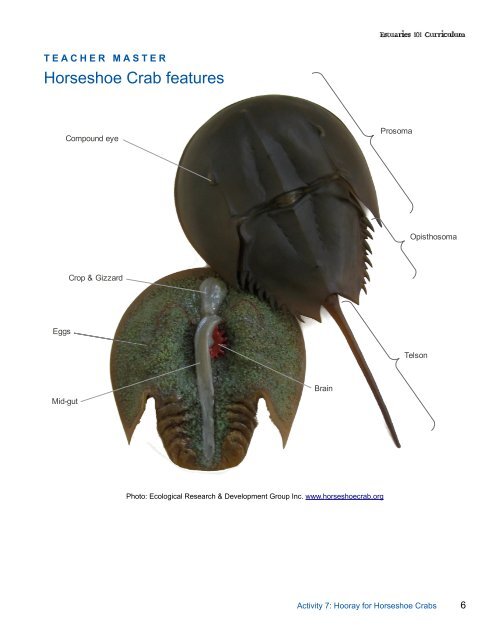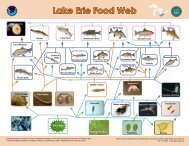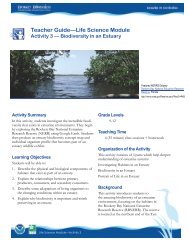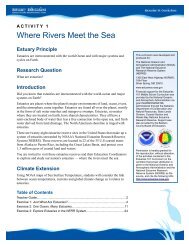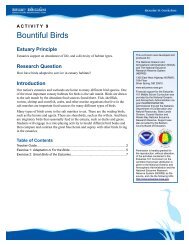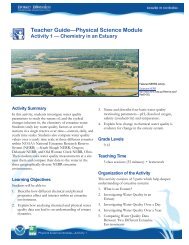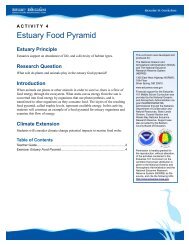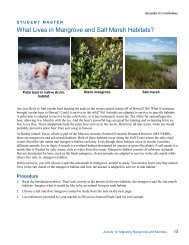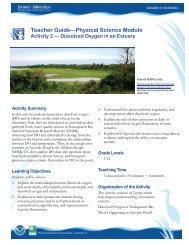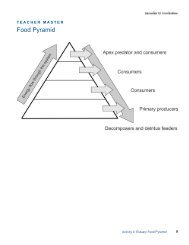Horseshoe Crab features - Estuaries NOAA
Horseshoe Crab features - Estuaries NOAA
Horseshoe Crab features - Estuaries NOAA
Create successful ePaper yourself
Turn your PDF publications into a flip-book with our unique Google optimized e-Paper software.
T E A C H E R M A S T E R<strong>Horseshoe</strong> <strong>Crab</strong> <strong>features</strong>Compound eyeProsomaOpisthosomaCrop & GizzardEggsTelsonMid-gutBrainPhoto: Ecological Research & Development Group Inc. www.horseshoecrab.orgActivity 7: Hooray for <strong>Horseshoe</strong> <strong>Crab</strong>s 6
T E A C H E R M A S T E R<strong>Horseshoe</strong> <strong>Crab</strong> <strong>features</strong>ArteriesHeartCheliceraePedipalpsMouthPusher legsBook gillsOperculumPhoto: Ecological Research & Development Group Inc. www.horseshoecrab.orgActivity 7: Hooray for <strong>Horseshoe</strong> <strong>Crab</strong>s 7
S T U D E N T M A S T E RHooray for <strong>Horseshoe</strong> <strong>Crab</strong>s<strong>Horseshoe</strong> <strong>Crab</strong>Photo: Ecological Research &Development Group Inc.Blue <strong>Crab</strong>Photo: Mary Hollinger,NODC biologist, <strong>NOAA</strong>SpiderPhoto: Brooke Vallaster,<strong>NOAA</strong>, Sapelo Island NERRWhen is a crab not a crab? Like other crabs, horseshoe crabs are arthropods. But so are spiders and scorpions. They allhave exoskeletons, a body divided into segments, and legs with joints. But horseshoe crabs are not true crabs. Theydon’t belong to the same class, Crustacea, as the blue crab and other crabs. True crabs have antennae, jaws, and onlyfive pairs of legs. <strong>Horseshoe</strong> crabs don’t have antennae or jaws and have six pairs of legs. <strong>Horseshoe</strong> crabs are in aclass of their own: Merastomata, which means “mouth surrounded by legs.<strong>Horseshoe</strong> crab fossils, similar in form to the ones you see in estuaries today, are found in rocks over 450 millionyears old. In this exercise, you are going to take a closer look at the anatomy of this ancient creature.Procedure1. Read the Background information sheet about horseshoe crab anatomy.2. Read the clues on the four horseshoe crab diagrams (view of the top and bottom, external <strong>features</strong> and internalorgans). Label the diagrams with the following <strong>features</strong> based on the clues and the information on the Backgroundinformation sheet.EggsCompound eyeProsomaCrop & gizzardTelsonMid-gutCheliceraeBrainMouthPedipalpsArteriesPusher legsHeartOperculumBook gillsOpisthosoma3. When you have finished labeling the horseshoe crab diagrams, answer the following questions.QuestionsQ1. What are the three main divisions of the horseshoe crab called?Q2. How do horseshoe crabs move through the water? How is that different than fish, birds, and humans?Activity 7: Hooray for <strong>Horseshoe</strong> <strong>Crab</strong>s 8
Q3. Why are horseshoe crabs considered to be arthropods? Why are they in the class Merastomata?Q4. Where does the horseshoe crab begin its life and how does it grow?Activity 7: Hooray for <strong>Horseshoe</strong> <strong>Crab</strong>s 9
S T U D E N T M A S T E RBackground: <strong>Horseshoe</strong> <strong>Crab</strong> AnatomyThe horseshoe crab’s body is divided into three sections. The front section is called the prosoma. The middle sectionis called the opisthosoma. And the horseshoe crab’s tail is called the telson. While the telson may look dangerous, thecrab mainly uses it for digging and to help turn itself back over if it gets flipped over on the beach. The telson is veryfragile. <strong>Horseshoe</strong> crabs should never be picked up by their tails.<strong>Horseshoe</strong> crabs are benthic animals, meaning that they normally live along the seafloor or bottom of an estuary’s bayor lagoon. <strong>Horseshoe</strong> crabs move underwater along the bottom or out of the water along the flat beach by using theirfive pairs of jointed legs. The fifth pair of larger pusher legs, found nearer the tail, is used to push the animal forward.Respiratory SystemLike many other aquatic animals, horseshoe crabs breathe through gills. They have six pairs of gills along the bottomof the opithosoma. These are called book gills because they look like pages in a book. The first pair of book gills iscalled the operculum, which helps protect the other gills and covers the opening of the pore through which the crabreleases either eggs or sperm.Circulatory System<strong>Horseshoe</strong> crabs have a long, tube-like heart that runs the length of their body (not the tail). It beats about 32 timesper minute, pumping the horseshoe crab’s blue blood through arteries and out into the rest of the crab’s body.Digestive System<strong>Horseshoe</strong> crabs eat small bivalves, mollusks, fish, worms, and algae. The horseshoe crab’s legs are covered withbristles that grind up the food as the crab walks, eventually pushing it toward the crab’s mouth, which is located at thepoint where all the legs meet. Two of those legs, called chelicerae, are not used for movement at all but rather forpushing food into the horseshoe crab’s mouth. Food that enters the mouth is first ground up in the crop and gizzardbefore passing into the mid-gut, which is where the food is finally digested.Nervous SystemThe horseshoe crab’s brain rests in the middle of the prosoma. Nerves run from the brain to the rest of the body,including to the horseshoe crab’s many eyes. The horseshoe crab has two compound eyes on the top of the prosoma.These eyes have many lenses, making them similar to the eyes of a housefly. There are five other eyes on the top ofthe horseshoe crab and two eyes near the mouth on the crab’s bottom. There are also light-sensitive photoreceptors onthe horseshoe crab’s tail.Life Cycle<strong>Horseshoe</strong> crabs live in the water, but come up onto the sandy beach to reproduce. The male horseshoe crab is usuallyabout one-third the size of the female. The male has two “boxing glove” like claws on its first set of walking legs.These specialized legs are called pedipalps and allow the male to hold onto the female during spawning. The femalehorseshoe crab is said to be larger than the male in order to hold a vast number of eggs within her body. Females laybetween 80,000 and 100,000 eggs in the sand during one spawning season. The eggs are about 1.5 mm (1/16 inch) indiameter and greenish tan in color. Fertilization of the eggs occurs outside of the body while the female is burying theeggs on the beach.<strong>Horseshoe</strong> crabs begin their lives as eggs buried in the sand on a beach. Many of the horseshoe crab eggs getuncovered and eaten by birds. Those that aren’t eaten are left to incubate in the sand. In about four weeks, babyhorseshoe crabs emerge from the eggs. <strong>Horseshoe</strong> crabs are like other animals with exoskeletons. As it grows, theActivity 7: Hooray for <strong>Horseshoe</strong> <strong>Crab</strong>s 10
horseshoe crab outgrows its shell, called a carapace. The crab molts, leaving its old shell behind and growing a new,larger shell. A horseshoe crab will molt 16 to 18 times over a period of about 10 years until it reaches adulthood.<strong>Horseshoe</strong> crabs can live to be about 20 years old if they do not get eaten by predators, get stranded on the beach,become injured, or get a disease.Activity 7: Hooray for <strong>Horseshoe</strong> <strong>Crab</strong>s 11
S T U D E N T M A S T E R<strong>Horseshoe</strong> <strong>Crab</strong>: External <strong>features</strong> (top view)These might be themost obvious, butthe horseshoe crabhas 5 additional eyeon its top, 2 on itsbottom, plus lightsensors along the topand bottom of itstail.The "head" sectionof the horseshoe crabcontains much of thecrab's nervous anddigestive system,plus the muscles tomove its legs.The horseshoe crab'smiddle sectionmostly contains themuscles needed tomove its tail and tobreathe.Less scary than itlooks, the crabcan use this toflip itself over if itgets turned overon its back.Activity 7: Hooray for <strong>Horseshoe</strong> <strong>Crab</strong>s 12
S T U D E N T M A S T E R<strong>Horseshoe</strong> <strong>Crab</strong>: External <strong>features</strong> (bottom view)This first pair of walkinglegs is also used by themale during spawning.More like arms thanlegs, these are usefulfor getting food intothe crab's mouth.The start of the crab'sdigestive tract islocated where all thelegs come together.When it comes timeto move, the last pairof legs gets the crabscuttling across thesand.<strong>Crab</strong>s have tobreathe and they getoxygen when watercirculates throughthe "pages" of these<strong>features</strong>.This covers the othergills and theopening throughwhich the crabreleases eggs orsperm.Activity 7: Hooray for <strong>Horseshoe</strong> <strong>Crab</strong>s 13
S T U D E N T M A S T E R<strong>Horseshoe</strong> <strong>Crab</strong>: Internal <strong>features</strong> (top view)The horseshoe crab'sblood leavesthrough these tubes,eventually goinginto the book gills toget oxygen beforereturning to theheart.This circulatory organextends almost theentire length of thehorseshoe crab's bodyand beat 32 times perminute.Activity 7: Hooray for <strong>Horseshoe</strong> <strong>Crab</strong>s 14
S T U D E N T M A S T E R<strong>Horseshoe</strong> <strong>Crab</strong>: Internal <strong>features</strong> (bottom view)Near the beginning of thehorseshoe crab's digestivetract, these parts gather thefood together and grind it toa pulp.An adult femalehorseshoe crab canlay over 80,000 ofthese each year.Like other animals, thisorgan is the center of thehorseshoe crab's nervoussystem.Pulverized food passesinto this part of thehorseshoe crab to bedigested.Activity 7: Hooray for <strong>Horseshoe</strong> <strong>Crab</strong>s 15


